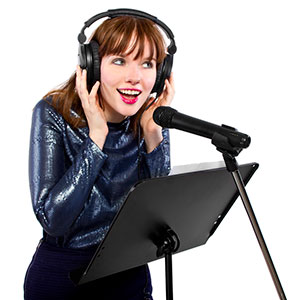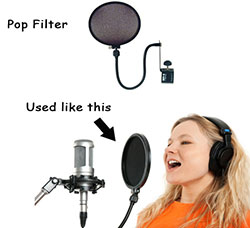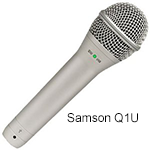Waverazor is a synthesizer. As it says in the review, you put in MIDI notes, and Waverazor plays a sound.
It is software synth (as opposed to a piece of standalone hardware like in the old days), available as a 32-bit and/or 64-bit plugin for Windows and Mac systems.
Check out this video:
It offers a unique continuous modulation of various parameters in each waveform slice that can be very useful for evolving sounds. A lot of the sounds that can be made with Waverazor will remind you of 70’s to 90’s manipulated sounds.
It offers old and a few new options, but is it worth buying?
Read about the verdict here: http://bedroomproducersblog.com/2017/06/11/waverazor-review/
Home Recording Equipment
Voice Over Recording Equipment
 Voice over recording equipment is more powerful and more affordable than ever before in 2017. Unlike the needs for musicians, voice over actors need very little in order to produce professional sounding results from their voice recording studio right from home.
Voice over recording equipment is more powerful and more affordable than ever before in 2017. Unlike the needs for musicians, voice over actors need very little in order to produce professional sounding results from their voice recording studio right from home.
Before I start claiming that all you need is a mic and a computer (which is pretty much true), or that the mic can be cheap (also true), I should qualify something.
Time Versus Money
In general, the cheaper the microphone and/or interface, the longer it will take you to record professional sounding voice overs. It is possible. But you sort of trade time for money. And for some, that’s OK. They may have more time than money. Lots of people do.
I actually include “time” in my list of voice over recording equipment. The reason for this is that you CAN record decent quality sound from a mic costing about 50 bucks (what I consider the minimum). But the less expensive gear tends to also record noise.
It is definitely possible to fix most noise problems with software after your record your voice. But that takes time. Some noise removal takes quite a lot of time.
What Takes So Long?

For instance, fixing p-pops (see our post How to Fix a “P-Pop” in Your Audio With Sound Editing Software for more on that) takes a lot more time to fix than to actually read the script you are recording. Removing saliva noises (see my post on that here How To Remove Saliva Noises From Voice Recordings) can take just as long. So if you are doing both, well you see where this is going.
I’ve now mentioned two bits of voice over recording equipment – time and a pop-filter. The pop filter will help prevent most of the p-popping, that bane of voice over recording. But I have never yet recorded a vocal where the filter prevented ALL p-pops. So you’ll want to know how to get rid of them after the fact, which is covered in the article linked above.
So What Are The Other Pieces Of Voice Over Recording Equipment You’ll Need?

Earlier I mentioned a microphone. I also said I thought you’d need to spend at least $50 or so, minimum, in order to get into the realm of professional sounding audio. That is how much it costs for a USB mic called the Samson Q2U (or Q1U). [update: The Q2U, which is the latest version of the Q1U, now has BOTH an XLR output AND a USB. That’s huge news. I’ll be doing a review of this mic in the coming weeks. Watch this space.]
If you can afford a bit more, I recommend the kind of set-up used my most professionals. By that I mean a standard (non-USB) microphone and an audio interface. The interface is a box that plugs into a computer, usually via USB. You plug the microphone into the interface.
The KIND of mic I recommend as your first upgrade from a USB mic is a “large diaphragm condenser” microphone. There are terrific for vocals. A good entry-level large diaphragm mic is an Audio-Technica AT2020, which you can get for about $99.
As for the interface, a great option is a Focusrite Scarlett Solo. One of those will also run about $99. Then along with that, of course you’ll need accessories like a mike stand and cable, and headphones to allow you to listen very closely to your recording, making sure you have no little noises between words and phrases. Those can be hard to hear with just speakers alone.
Amazon has a studio kit that has all you need to get started. It has the Focusrite interface, microphone, mic cable and headphones. Here is a link to the Focusrite Scarlett Solo Studio Bundle. That bundle, plus the addition of a mic stand and pop-filter, will run about $256.
the last piece of your voice over recording studio puzzle is the software. Fortunately, the free Audacity is truly all you need to get started. You can learn how to use it in our course, the Newbies Guide To Audio Recording Awesomeness.
As you are able to afford it, you can easily upgrade this studio by trying out better and better mics. But you may not ever need to! You may find the studio bundle is all you need to sound as professional as necessary to become a pro.

The Top Plug-ins For A Better Mix
Music production can be quite a handful, from the beginning of editing to mixing and all the other things in between. That is why it is always good to have a list of tools that can help you along the way. Mixing can be a lot easier and productive once you expand your vision, here are a list of plug-ins to help you along the way.
The intention of the collection is to improve innovation and solving specific problems thus increasing productivity. But before we begin first things first, if you want to get far enough you must have a reliable system.
Read more here: http://en.audiofanzine.com/getting-started/editorial/articles/the-best-audio-plug-ins-for-mixing.html
The Top DAW's Available Today
The evolution in technology has really affected the way we look at audio software. You can just go to a store and purchase any digital audio workstation and it’s just easy to use and much more powerful. The problem is with the many choices out there which one are you going to choose? Here is a short list of what’s available today. Now, these may not be up against the top, but this list considers all parameters of what people actually use from amateurs to professionals, and reading dozens of articles that actually went one way or the other in terms of what’s on top.
See the complete list here: http://bobbyowsinskiblog.com/2017/06/08/top-daw/
Your Guide To Buying A PA System
With different choices and combinations out in the market today, from brands to specifications to features and much more, finding a PA system tends to be more stressful than fulfilling.
Not to mention we always want to find good value for money. Don’t stress yourself with the technical details if you intend to buy a PA system rather consider these basic things and make buying you system as simple as possible.
The first thing you need to consider is you need to understand the two main types of PA systems. Also, consider where you are going to place your system. You don’t want to buy something that will overpower your space.
Read more here: https://www.audiolinks.com/blog/the-audiolinks-guide-to-buying-a-pa-system/